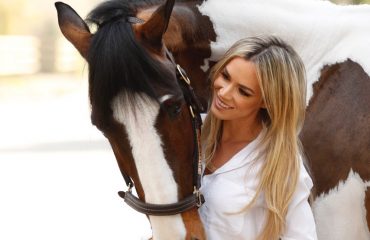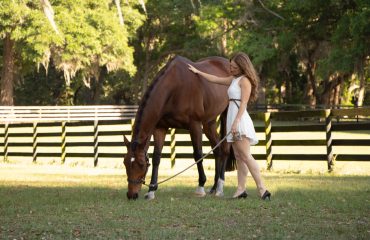What would you look for in an OTTB? I’m considering one for low-level eventing and would like to know your thoughts on what’s desirable. — Angel, via Facebook
For the first half of my career, I became somewhat of an expert at trying to pick a Thoroughbred that had changed careers and had potential for eventing. After much trial and error, I came up with some criteria that would put the laws of probability on your side.
A big thing is evaluating the character of the horse. Obviously, it’s easier to train a quiet, clear-thinking, relaxed horse. A lot of Thoroughbreds who have just finished racing are pretty fiery and hot. Some will settle down once they’re away from the track, but some stay fresh and frantic forever. If there’s a way to get a feel for whether it’s a calmer horse, it makes life so much easier.
Next, I look for the type. Sadly, in American racing there is a lot of 2-year-old sprinting, for which breeders tend to produce a somewhat smaller, shorter, more downhill horse. These types of horses are hard to convert to eventing. If you can, find yourself a big, uphill, strong-boned-type Thoroughbred with a better trot and more of a championship look once they change to their new career.
Third, conformation is important. Obviously, we want a horse to last another 12 to 15 years; if we can evaluate the horse’s legs and feet, correct-shaped feet with good angles leads to a sounder horse later. A horse that has fairly straight action with its legs will also stay sounder longer.
Fourth is trying to evaluate the horse’s natural talent. You want swing in the trot, a balanced canter and a good walk. It’s hard in the early days to evaluate the jump, so all I’m looking for is the horse’s natural jump. You want the horse’s natural instinct to be to ping upwards. Over time, you can improve the technique through training, but usually a horse’s natural scope and power is his total scope and power — that’s a hard thing to build into the horse as time goes on.
There are always exceptions to the rules. Some horses’ jump will change over time; some will stay hot, some will quiet down; or a horse with crooked legs might stay sound forever. It’s hard to find a perfect horse and I would recommend that you forgive one or two dings if you really like the animal.
My horse tosses his head and breaks from trot to canter, fighting the bit, on the approach to a jump, when heading toward home. He gets very strong and rushes. He’s not attached to a buddy or sour about leaving his pasture, he generally loves to work. Any advice? — Caitlin, via Facebook
First things first, you have to really work hard at getting your horse in a correct frame. This can take thousands of hours, months of training on the flat getting the horse accepting the bridle, moving off your leg and working soft through his back. Start with a rail on the ground and maintain this softness and even connection before, during and after the pole on the ground. As time goes on, change that pole to a little jump, still insisting on correctness before, over and after the jump. It’s very simple; some people will go to gadgets and fancy bits, bridles and draw reins, but there is no replacement for fundamental training. Your horse is not a robot where you pull this lever and push that button; it takes hours and hours to develop the correct basics, and eventually you’ll get there.
Do you have any tips for keeping a green or anxious horse calm in a new environment, like at a show? — Adrianne, via Facebook
The first thing I’d advise is repetition. Some horses get more nervous than others, but the more you can expose your animal to different environments and new experiences, the better. Everyone is excited by a new experience and the more you do it the less exciting it becomes. The first step is to get them going really well at home, then off your property, to another farm down the road, to schooling shows and so on. The more we do this and school them, eventually they’ll take a breath and go in the same manner that they go at home. Obviously there are different techniques like pre-riding, lunging, calming supplements and so on, but the most basic thing is repetition until it becomes no big deal to go somewhere new.
Eventing photo:
Boyd advises taking green or anxious horses to new environments and expose them to new experiences before they are ready to compete.
Photo by Ruby Tevis













